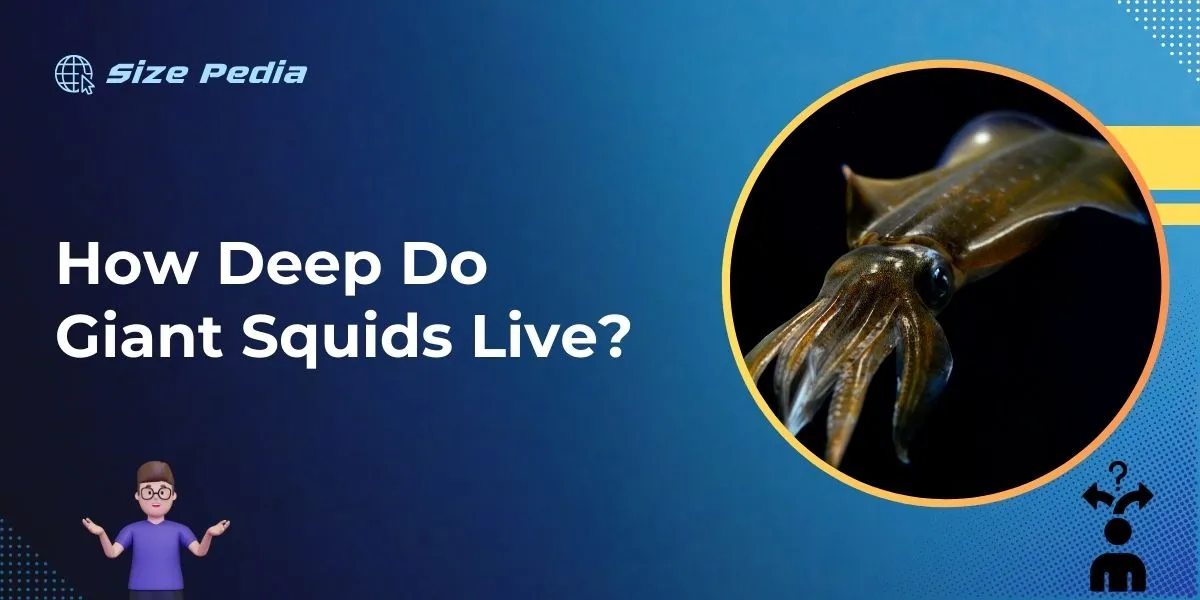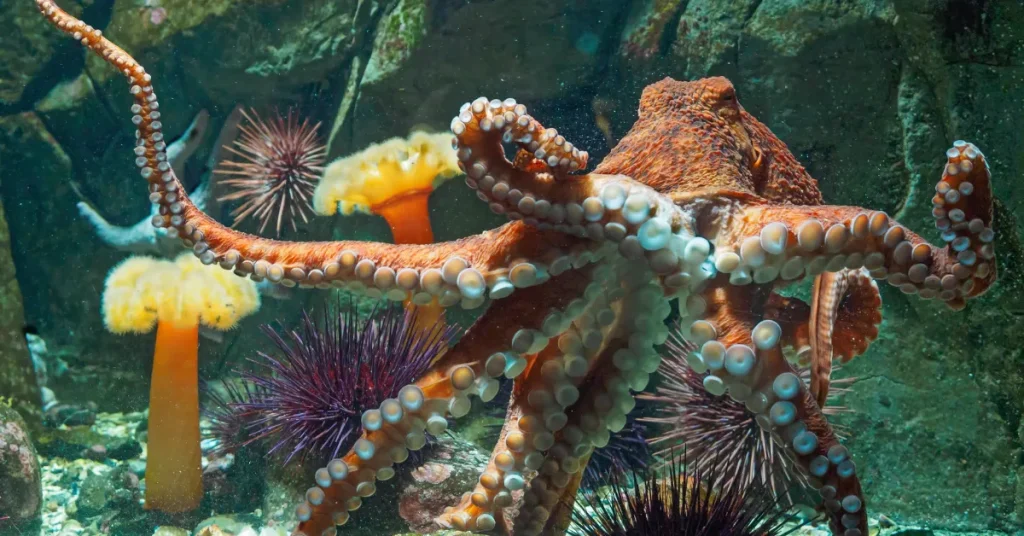Giant squids typically live at depths of around 300 to 1000 meters. Their habitat extends into the deep sea’s midnight zone.
Deep beneath the ocean’s surface, the giant squid remains one of nature’s most enigmatic creatures.
Thriving far from sunlight, these cephalopods inhabit a world where the pressures are immense and the darkness is pervasive. Scientists have long studied giant squids to understand their behaviors and adaptations to such inhospitable conditions.
With telescopic eyes and enormous tentacles, they are perfectly designed for a life in the profound depths. The elusive nature of the giant squid has piqued human curiosity for centuries, inspiring maritime folklore and challenging researchers to uncover its secrets.
Despite their remote habitat, occasional strandings and the advancement of deep-sea exploration technology are gradually illuminating the mysterious life of the giant squid.

The Enigma Of Giant Squids
Giant squids are one of the ocean’s most mysterious creatures. These elusive giants captivate our imaginations with their remarkable size and deep-sea dwelling habits.
The Lore Around Giant Squids
Tales of giant squids have haunted sailors for centuries. They appear in ancient legends as sea monsters, capable of dragging whole ships into the abyss.
- Kraken myth from Norse sagas
- 20,000 Leagues Under the Sea – Jules Verne’s classic
- Modern sightings sparking scientific interest
Physical Characteristics Of Giant Squids
Giant squids are remarkable not only for their size but for their fascinating biology.
| Attribute | Description |
| Size | Can grow up to 43 feet long |
| Eyes | Size of a dinner plate, largest in the animal kingdom |
| Tentacles | Equipped with suction cups and hooks for hunting |
These physical traits help giant squids thrive in deep ocean layers, often below 2,000 feet.
Habitats Of The Deep

The ocean’s abyss hides many secrets, one being the habitat of the elusive giant squid. These magnificent creatures dwell within the depths of the ocean. Their homes are far beyond the reach of sunlight, in a world that’s both mysterious and fascinating.
Typical Environments For Giant Squids
Giant squids prefer cold, deep waters. Researchers believe they inhabit spaces between 300 to 1000 meters below sea level. Here, darkness reigns.
- Submarine canyons: Nutrient-rich and full of life.
- Deep-sea trenches: Some of the most remote ocean areas.
- Continental slopes: Steep inclines where the ocean floor drops off.
Their choice of habitat protects them from predators while providing access to a variety of prey.
The Importance Of Depth To Their Lifestyle
Depth is crucial to giant squids. It offers them protection and ample food sources. Life at such depths requires remarkable adaptations.
| Depth (meters) | Features | Lifestyle Benefit |
| 300 – 600 | Near-total darkness | Camouflage from predators |
| 600 – 900 | Lower temperatures | Slowed metabolism, energy efficiency |
| 900+ | High pressure | Specialized cells and organs |
This depth ensures a perfect environment for their incredible size and unique feeding methods.
Technological Pursuits
The ocean’s depths conceal many secrets, and the elusive giant squid is one of them. Thanks to advancing technology, researchers can now dive deeper into the aquatic abyss to study these mysterious creatures.
Technological pursuits in marine biology have enabled us to overcome the challenges of depth, pressure, and darkness. This opens a new window into the lives of giant squids.
Underwater Vehicles In Squid Research
The key to unlocking the depths where giant squids reside lies in cutting-edge underwater vehicles. These remotely operated vehicles (ROVs) and autonomous underwater vehicles (AUVs) are the eyes and hands of scientists in the deep sea.
- ROVs are tethered to ships, sending back real-time data.
- AUVs work independently, reaching areas that are too risky for human divers.
Both types of vehicles can venture down, capturing images and videos of the giant squid in its natural habitat, sometimes over 2,000 meters below the surface.
Advances In Deep-sea Exploration Technology
Exploring the profound depths requires not just courage, but also innovation. Recent technological advances have significantly improved our capability to study marine life.
| Technology | Impact on Squid Research |
| Pressure-resistant materials | Vehicles can dive deeper without being crushed. |
| High-definition cameras | Scientists can observe squids in stunning detail. |
| Artificial intelligence | Helps in identifying and tracking squids automatically. |
| Bio-inspired design | Underwater vehicles mimic marine animals to get closer without startling them. |
This combination of strength, visibility, smarts, and stealth brings us closer than ever to understanding giant squids.
Encounters With The Giants

The depths of the ocean hold eerie secrets, with giant squids as enigmatic characters. These elusive creatures dwell in darkness far below the waves, rarely seen by human eyes.
‘Encounters with the Giants’ dives deep into the mysterious world of the giant squid, revealing rare interactions that shed light on their shadowy existence.
Documented Sightings And Captures
Giant squids, masters of the deep, have long captured human imagination. Actual sightings and captures remain scarce, yet each is a treasure trove of insight.
- First photographic evidence: a giant squid in its natural habitat, captured in 2004.
- Commercial fishing nets occasionally snag these deep-ocean dwellers.
- Stranded specimens on shores offer a glimpse into their massive proportions.
With formidable tentacles and eyes as large as dinner plates, these giants inspire both fear and fascination. Despite these rare encounters, much about giant squids remains unknown.
Current Research And Knowledge On Behavior
Recent advancements in technology usher in a new era of discovery. With state-of-the-art equipment, researchers plunge into the abyss to study these cephalopods.
| Method | Purpose | Outcome |
| Deep-sea cameras | Observing natural behavior | Rare footage in their habitat |
| Genetic analysis | Understanding lineage and diversity | Insights into evolution and genetics |
| Biological sampling | Analyzing diet and health | Data on prey and ecosystem role |
Each research endeavor reveals astonishing details about giant squids. By decoding their mysterious lives, scientists take vital steps toward deciphering the ocean’s enigmas.
As we explore the vast blue, the giants of the deep teach us the humility of our knowledge and the boundless potential for discovery.
Conservation And Future Research
The enigmatic giant squid remains one of the ocean’s most compelling mysteries. While their elusive nature is captivating, it poses significant challenges for conservation and necessitates innovative research strategies.
Efforts to understand and protect these deep-sea dwellers have intensified, with novel approaches on the horizon.
Challenges In Protecting Deep-sea Creatures
Deep-sea creatures like the giant squid face threats from human activities. These include overfishing, climate change, and deep-sea mining. However, the remote depths in which they reside make conservation efforts particularly tricky. Here’s why:
- Habitat depth beyond 2000 meters limits regular human access
- Lack of comprehensive scientific data hampers understanding
- Regulations and legislation are tough to implement in international waters
The Next Frontier In Giant Squid Research
As interest in these undersea giants grows, so too does the imperative for pioneering research. Progress hinges on several areas:
- Advanced underwater technologies, such as autonomous submarines
- Genetic sampling for population studies without requiring physical specimens
- Partnerships with international conservation organizations focusing on biodiversity
Such measures aim not just to deepen our knowledge but also to foster conservation strategies that can protect the giant squid for generations to come.
Continuing research into their mysterious lives offers us a glimpse into the complex biodiversity of our planet’s depths.
FAQs About How Deep Do Giant Squids Live
What Depth Do Giant Squids Inhabit?
Giant squids primarily dwell in deep ocean waters, typically ranging between 300 to 1000 meters. Exceptionally, some have been spotted over 2000 meters deep. This depth range provides the darkness and cold they prefer.
How Large Can Giant Squids Grow?
Giant squids can reach impressive sizes, with mantle lengths up to 2 meters and overall lengths around 13 meters. Their formidable size includes long tentacles, which they use for hunting prey in deep waters.
Are Giant Squids The Largest Invertebrates?
Yes, giant squids are considered the largest invertebrates on Earth. Their massive bodies and elongated tentacles set the record for invertebrate size, exceeding any other known marine invertebrates.
What Do Giant Squids Eat?
Giant squids prey on deep-sea fish and other squid species. Their diet reflects their predatory nature and the availability of food in the deep ocean environments where they reside.
Conclusion
Diving into the depths of our oceans reveals the giant squid’s remarkable habitat. Typically found at depths between 300 and 1000 meters, these elusive creatures can venture even deeper.
Our fascination and research continually broaden our understanding, but much remains a mystery.
Embrace the enigma of the ocean’s depths as we strive to learn more about these astonishing animals.
Resources:
1.https://seawifs.gsfc.nasa.gov/OCEAN_PLANET/HTML/squid_Architeuthis.html
